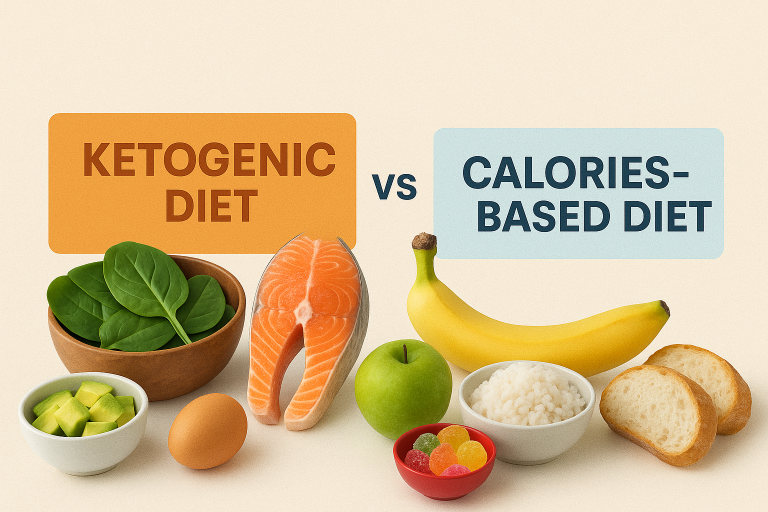Ketogenic Diet vs. Calories-Based Diet: What’s the Difference and Which One Is Right for You?
- June 10, 2025
- Saurabh Kale
- 9:28 pm

When it comes to weight loss and fitness, the internet is packed with advice—but two popular approaches keep coming up: the ketogenic diet and the calories-based diet. Both have loyal followers and proven results, but they operate on very different principles.
In this article, we’ll break down the major differences between a keto diet plan and a calorie-counting diet, helping you understand how each works and which one is right for your lifestyle.
What Is a Ketogenic Diet?
The ketogenic diet (or keto diet) is a low-carb, high-fat nutrition plan that puts your body into a state called ketosis. In ketosis, your body starts burning fat instead of carbs for energy.
Typical Macronutrient Breakdown:
Fat: 70–75%
Protein: 20–25%
Carbs: 5–10%
By slashing your carb intake to around 20–50 grams per day, your liver starts producing ketones, which your body uses for fuel instead of glucose.
Allowed Foods:
Eggs, meat, fatty fish
Avocados, nuts, seeds
Cheese, butter, oils
Leafy greens and non-starchy veggies
Restricted Foods:
Bread, pasta, rice
Sugar, desserts, sweetened beverages
Most fruits and root vegetables
What Is a Calories-Based Diet?
A calories-based diet follows a simple rule: eat fewer calories than your body burns to lose weight—known as a calorie deficit. It doesn’t focus on food types but on overall intake.
Core Principle:
Calories In < Calories Out = Weight Loss
You can eat anything—pizza, rice, chocolate—as long as it fits your daily calorie goal. It’s all about balance and portion control.
How It Works:
Determine your Total Daily Energy Expenditure (TDEE)
Track food intake using apps (e.g., MyFitnessPal, HealthifyMe)
Create a daily deficit (typically 500–700 calories for weight loss)
| Features | Ketogenic Diet | Calories-Based Diet |
|---|---|---|
| Primary Focus | Burn fat via ketosis | Create calorie deficit |
| Macronutrients | High fat, low carb | Flexible, any ratio |
| Food Choices | Restricted (low-carb only) | Wide variety allowed |
| Tracking Method | Macros (carbs, fat, protein) | Calories only |
| Sustainability | Tougher for long-term adherence | Easier to maintain |
| Speed of Results | Rapid fat loss possible | Slower, steady progress |
Which Diet Plan Should You Choose?
Go with Keto if:
You’re targeting fast fat loss
You want to cut down on sugar and processed carbs
You enjoy foods like eggs, cheese, meat, and healthy fats
You’re managing insulin resistance or type 2 diabetes (under doctor’s advice)
Go with a Calories-Based Diet if:
You prefer flexibility in your meals
You want to eat a variety of foods, including carbs
You’re looking for a long-term, sustainable approach
You enjoy occasional treats and social eating
Final Thoughts
The keto diet and calorie-counting diet both lead to weight loss—but by very different means. Keto pushes your body into fat-burning mode through carb restriction, while a calorie-focused approach offers freedom and long-term manageability.
There’s no one-size-fits-all answer. The best diet plan is the one you can stick to, enjoy, and maintain without feeling restricted.
Have you tried keto or calorie tracking before?
Share your experience in the comments below or ask your questions—we’re here to help you find the path that works for you.
One thought on “Ketogenic Diet vs. Calories-Based Diet: What’s the Difference and Which One Is Right for You?”
Sagar Ghadage
Insightful